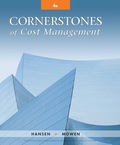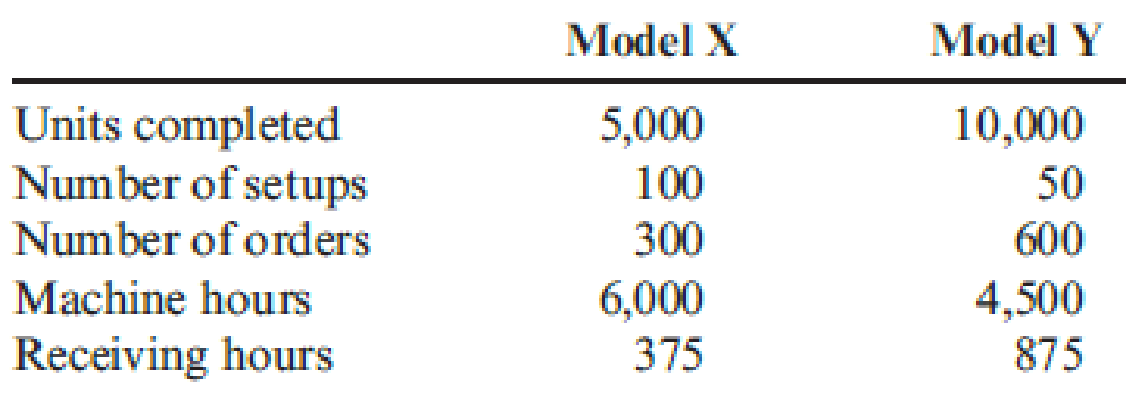
Silven Company has identified the following

Silven produces two models of cell phones with the following expected activity demands:

- 1. Determine the total overhead assigned to each product using the four activity drivers.
- 2. Determine the total overhead assigned to each model using the two most expensive activities. The costs of the two relatively inexpensive activities are allocated to the two expensive activities in proportion to their costs.
- 3. Using ABC as the benchmark, calculate the percentage error and comment on the accuracy of the reduced system. Explain why this approach may be desirable.
1.
Compute the predetermined overhead rates of S Company and the total overhead cost assigned to each product.
Explanation of Solution
Predetermined overhead rate: It is an application of estimated manufacturing overhead cost over the cost object for particular time period. Predetermined overhead rate is used to calculate the overhead used per unit of a driver.
Formula:
Compute the predetermined overheads rates for all the activities of S Company.
| Activity | Overhead rates |
| Setting up equipment | |
| Ordering materials | |
| Machining | |
| Receiving |
Table (1)
Calculate the cost assigned to be assigned to each product using the four activity drivers.
| Activity |
Model X ($) |
Model Y ($) |
| Setting up equipment | 84,000 (1) | 42,000 (2) |
| Ordering materials | 6,000 (3) | 12,000 (4) |
| Machining | 72,000 (5) | 54,000 (6) |
| Receiving | 9,000 (7) | 21,000 (8) |
| Total overhead assigned | $171,000 | $129,000 |
Table (2)
Working notes: Calculate the applied overheads for both the models of S Company
Applied overhead: Applied overhead is a cost which cannot be assigned directly to a cost object, and it is a fixed charge on a specific production department in the company.
Formula:
(1) Calculate the applied overheads for the activity of setting up equipment for Model X.
(2) Calculate the applied overheads for the activity of setting up equipment for Model Y.
(3) Calculate the applied overheads for the activity of ordering materials for Model X.
(4) Calculate the applied overheads for the activity of ordering materials for Model Y.
(5) Calculate the applied overheads for the activity of machining for Model X.
(6) Calculate the applied overheads for the activity of machining for Model Y.
(7) Calculate the applied overheads for the activity of receiving for Model X.
(8) Calculate the applied overheads for the activity of receiving for Model Y.
2.
Calculate the total overhead assigned to both the models of S Company by using the two most expensive activities.
Explanation of Solution
Calculate the total overhead assigned to both the models of S Company by using the two most expensive activities.
| Activity |
Model X ($) |
Model Y ($) |
| Setting up equipment | 100,000(1) | 50,000(2) |
| Machining | 85,740(3) | 64,305(4) |
| Total Overhead assigned | 185,740 | 114,305 |
Table (3)
Step 1: Calculate the new activity rates of S Company namely setting up equipment and machining activity.
Setting up equipment:
Machining:
Step 2: Compute the total applied overheads assigned to both the models of S Company.
(1) Calculate the applied overhead of setting up equipment for Model X.
(2) Calculate the applied overhead of setting up equipment for Model Y.
(3) Calculate the applied overhead of machining activity for Model X.
(4) Calculate the applied overhead of machining activity for Model Y.
Compute the new cost pools for the activities of setting up equipment and machining of S Company.
Setting up equipment:
Machining:
Compute the new activity rates for both the activities of S Company.
| Activity |
Model X ($) |
Model Y ($) |
| Setting up equipment | 100,000(1) | 50,000(2) |
| Machining | 85,740(3) | 64,305(4) |
| Total Overheads assigned | 185,740 | 114,305 |
Table (4)
Working notes:
(1) Calculate the new activity rates for setup activity.
Setting up equipment:
(2) Calculate the new activity rates for machining activity.
Machining activity:
3.
Compute the percentage of error and provide information on the accuracy of reduced costing system considering activity based costing as a benchmark.
Explanation of Solution
Calculate the percentage of error for Model X of S Company.
Calculate the percentage of error for Model Yof S Company.
The degree of error is not significant in the calculated result which means the activity drivers selected to calculate overhead rates are accepted and are better accurate in contrast to activity based costing.
Want to see more full solutions like this?
Chapter 4 Solutions
EBK CORNERSTONES OF COST MANAGEMENT
- What was the company's net operating income for the year on these financial accounting question?arrow_forwardThe fiscal 2010 financial statements for Neptune, Inc report revenues of $14,892,615, net operating profit after tax of $987,625, net operating assets of $6,124,587. The fiscal 2009 balance sheet reports net operating assets of $5,995,633. What is Neptune s 2010 net operating profit margin?arrow_forwardPlease help with accounting question is solvearrow_forward
 Cornerstones of Cost Management (Cornerstones Ser...AccountingISBN:9781305970663Author:Don R. Hansen, Maryanne M. MowenPublisher:Cengage Learning
Cornerstones of Cost Management (Cornerstones Ser...AccountingISBN:9781305970663Author:Don R. Hansen, Maryanne M. MowenPublisher:Cengage Learning Excel Applications for Accounting PrinciplesAccountingISBN:9781111581565Author:Gaylord N. SmithPublisher:Cengage Learning
Excel Applications for Accounting PrinciplesAccountingISBN:9781111581565Author:Gaylord N. SmithPublisher:Cengage Learning Essentials of Business Analytics (MindTap Course ...StatisticsISBN:9781305627734Author:Jeffrey D. Camm, James J. Cochran, Michael J. Fry, Jeffrey W. Ohlmann, David R. AndersonPublisher:Cengage Learning
Essentials of Business Analytics (MindTap Course ...StatisticsISBN:9781305627734Author:Jeffrey D. Camm, James J. Cochran, Michael J. Fry, Jeffrey W. Ohlmann, David R. AndersonPublisher:Cengage Learning- Principles of Accounting Volume 2AccountingISBN:9781947172609Author:OpenStaxPublisher:OpenStax College
 Managerial AccountingAccountingISBN:9781337912020Author:Carl Warren, Ph.d. Cma William B. TaylerPublisher:South-Western College Pub
Managerial AccountingAccountingISBN:9781337912020Author:Carl Warren, Ph.d. Cma William B. TaylerPublisher:South-Western College Pub Financial And Managerial AccountingAccountingISBN:9781337902663Author:WARREN, Carl S.Publisher:Cengage Learning,
Financial And Managerial AccountingAccountingISBN:9781337902663Author:WARREN, Carl S.Publisher:Cengage Learning,





